|
If you're a long-standing fan of martial arts cinema, you should be familiar with the name Wong Fei-hung, a real-life 19th century martial artist and physician who became a Chinese folk hero so legendary that he has featured in over 100 films and television series, in which he has been portrayed by genre stars of considerable note. Jackie Chan played him in Drunken Master and its sequel, Gordon Liu did likewise in Challenge of the Masters (1976) and Martial Club (1981), Jet Li had his turn in Last Hero in China (1993) and Sammo Hung briefly had his turn in Around the World in 80 Days (2004). He was played by Vincent Zhao in a 1996 TV series produced by widely respected genre filmmaker Tsui Hark, but by then Hark had produced a series of six films that for many have become the definitive Wong Fei-hung movies. Indeed, the original Chinese title of the first film in the series was Wong Fei Hung. In the West it was released as Once Upon a Time in China.
The importance of this film to martial arts cinema cannot be overstated. By the early 1990s, Interest in this once-profitable genre was in serious decline and kung-fu movies of note were by then few and far between, and the huge commercial success of Once Upon a Time in China effectively kicked off martial arts cinema's third wave. It made a star of its leading man Jet Li and is often credited as the movie that introduced the wire-assisted combat of wushu cinema to western audiences, sparking an enthusiasm for the genre that paved the way for bigger-budgeted and internationally successful works such as The House of Flying Daggers, Hero and Crouching Tiger, Hidden Dragon. It spawned numerous imitators and five direct sequels, the first two of which were also directed by Hark and featured Jet Li in the lead. In the lower-budgeted fourth film Wong was played Vincent Zhao, who returned for a fifth film and went on to reprise the role in Hark's 1996 TV series spin-off. The sixth and final film, Once Upon a Time in China and America, was directed and choreographed by genre legend Sammo Hung and marked Jet Li's return to the role of Wong Fei-hung.
Although billed as the Once Upon a Time in China trilogy, Eureka's Limited Edition box set includes not only the first three films, but also the sixth, all of them restored and accompanied by a blend of newly shot and sourced-from-DVD special features. My original aim was to cover each film more concisely than usual in an effort to cut the review down to size and hopefully get it finished and posted close to the release date. I failed miserably, in part because the films themselves deserve more than a couple of paragraphs each and the special features took a considerable time to watch and write about. So let's get to it...
| Once Upon a Time in China |
|
The first film in the series kicks off with a preface set aboard a Chinese naval vessel, where we are introduced to Wong Fei-hung and his wire-assisted acrobatics as he defiantly makes his way up the rigging of a ship dressed as a dancing lion, and is then informed by his superior that the Navy is to be disbanded. This is Foshan in the late 19th century, a time when the region was undergoing change and was awash with French, British and American naval vessels and personnel.

Following a visually striking title sequence featuring an army of identically dressed martial artists practising their skills in perfect unison on a gorgeously sunlit beach, we move on to the main story, and there's quite a bit to keep tabs on here. We quickly realise that Wong is a popular figure in Foshan, and that he divides his time between his medical practice and training the local militia in martial arts. He has three apprentices in the shape of Porky Wing, Bucktooth So and the more plainly named Kai, the only one who hasn't been given a nickname inspired by his appearance. They are joined early on by Siu-kwan, who despite being Wong's age and only distantly related to him is referred to by everyone as 13th Aunt. Wong clearly has feelings for her (and given that she is played by the beautiful Rosamund Kwan, it's not hard to see why) and she for him (ditto – come on, Jet Li looks great here), but the two are too constrained by the social norms of the day to take this any further. Siu-kwan has just returned from England and sticks out a little with her westernised clothes and her plate camera and tripod, and she quickly becomes the subject of a crush by Leung Foon (Yuen Biao), a clumsy stagehand for a newly arrived travelling opera troupe.
When Leung Foon starts a fight with the local Shaho Gang, it spills into a restaurant in which Wong is meeting with representatives of the British and American military presence. A battle breaks out between the Shaho Gang and members of the local militia, but after the gang have been seen off, the district Governor blames the whole thing on Wong and has the militia disbanded and its members arrested. Yes, the man's an idiot, but he's only just getting started. A short while later, Wong saves the Governor's worthless life when the Shaho Gang mount an assassination attempt, and during the confusion that follows many civilians are shot by military personnel. So what does the Governor do? He blames Wong again and wants him arrested and executed. What? Complicating things further is the arrival in town of ‘Iron Vest' Yim, a strong and skilled but down-on-his-luck fighter who is looking to start his own martial arts school and make a name for himself by challenging and beating the famous Wong Fei-hung.
There's considerably more to this than even that outline might suggest, and the busy nature of the plotting is one of ways in which Once Upon a Time in China stands apart from a good many of its genre predecessors. Where in past films the story would often be a threadbare tale of revenge and sullied honour whose primary function was to move us from one action set-piece to the next, here the narrative is complex, multi-stranded and laced with interesting character detail and socio-political commentary. Indeed, there were times in the first half when I could almost believe that I was not watching a martial arts movie at all but a prestige historical drama laced with action scenes.
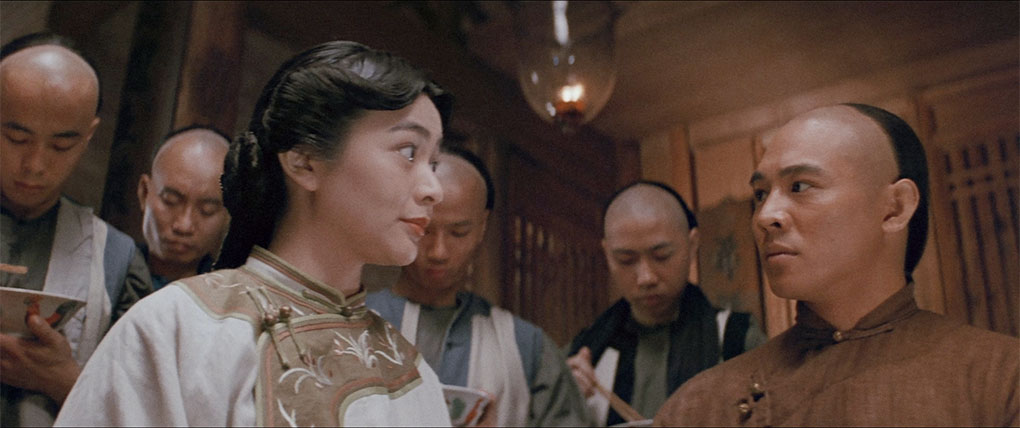
This air of quality is established from the get-go by the film's rich production design and gorgeous scope photography – which is credited to astonishing six cinematographers (Ardy Lam, Bill Wong, David Chung, Arthur Wong, Wingo Chan and Wilson Chan) – and by Hark's sometimes epic eye for camera placement and movement. Our introduction to Foshan is a case in point, an effortlessly complex crane shot that drifts across and through the window of an upstairs tea room, down into the street below and through a throng of people before settling on and tracking back with a gaggle of Christian missionaries as they lead their local flock and sing their hallelujahs – amusingly, the tea room musicians respond with a weary "not again" and promptly increase the volume of their playing to drown them out. This also slyly sets up one of the film's central themes, that of a populace that believes its traditions and values are being undermined by outside influences and are trying to face up to the impact of changing times. This is illustrated not only by the haughty British and American military officers but by Siu-kwan's embracement of western dress codes and technology, which feels as oddly out-of-place to us as it does to the Foshan locals. The newly established international trade also has its dark side, in the market stall luring local men to San Francisco where they will unknowingly become slave labour for American companies, and in the gang that is rounding up Chinese women to ship to the States and force into prostitution.
Where the film also stands apart from its genre predecessors is in its refusal to cast its key characters in binary oppositional terms. That Wong will be presented as the good guy throughout is never in doubt, especially given his legendary standing, but he's not quite the symbol of flawless purity so common in 70s kung-fu cinema, being unsure of himself with women and getting into fights with Leung Foon for no other reason than the two seem unable to communicate with each other. Even more interesting on this score is Iron Vest Yim, who in previous genre films would be set up from the start as an amoral bad guy, but here is humanised from the moment we first see him performing stunts in the street for coins that he has to crawl around in the mud to collect. Even when he joins the Shaho Gang after beating a distracted Wong in a fight, a quiet conversation with his despairing new disciple Leung Foon makes it clear that he is not driven by hate or a lust for power, but a desperate yearning to restore something of his lost former pride.
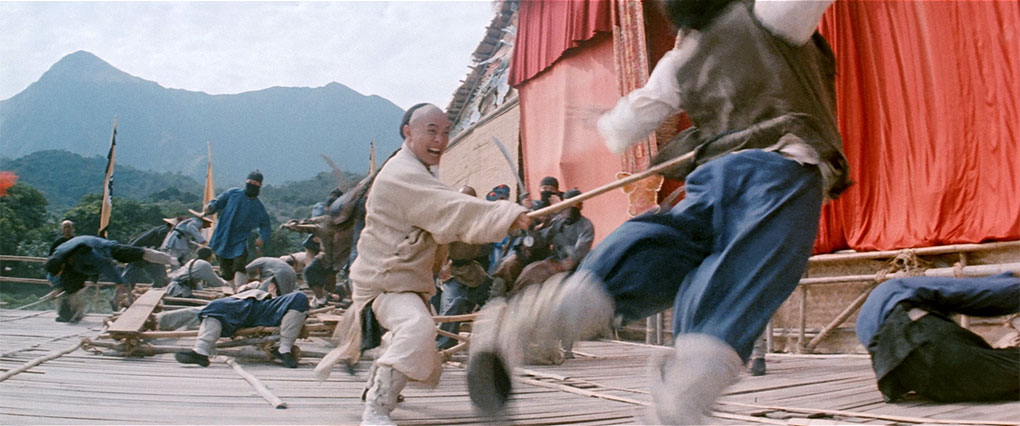
When the fighting explodes, it's always spectacular, although the involvement of three separate fight choreographers (Yuen Cheung-yan, Yuen Woo-Ping and Lau Kar-wing, whose father was a pupil of none other than Wong Fei-yung) does result in some variance in style, but all are inventive and the best – Wong's furious battle with a band would-be assassins is a blizzard of high speed hits, kicks and stick fighting – are genuinely thrilling to watch. It builds to a final half-hour of blistering action, peaking in a dazzling climactic battle between Wong and Yim that makes acrobatic use of warehouse rafters and ladders. This is all the more impressive when you learn that Jet Li was being doubled for some shots after breaking his leg (in a stunt that is still in the film) but is still throwing himself about energetically in others, and that his dizzyingly skilled and acrobatic opponent Yen Shi-kwan was in his mid-40s at the time of filming.
Everything clicks here, and the result is an enormously impressive and immensely entertaining action-drama with a sizeable roster of well-drawn and engaging characters, and a plot with enough threads and meat to justify the film's unusually long two-and-a-quarter hour running time. Even that Hong Kong cinema penchant for overplaying the emotional moments is largely kept in check here, though some serious licence is taken to maximise the impact of the slaughter of civilians in a hail of gunfire that could simply not have been delivered by officers armed with muskets that take a good minute or so to reload between shots. It doesn't matter a jot. Once Upon a Time in China is a genuine action classic that single-handedly revitalised a waning genre and remains to this day one of the leading lights of the third wave of Hong Kong martial arts cinema.
| Once Upon a Time in China II |
|
We all know how rare it is for an acclaimed original to be followed by a sequel of equal quality, but that's just what happened with Once Upon a Time in China II. Some, including the venerable gentlemen who provide the commentary tracks for the first three films, are of the opinion that it's actually superior, but I'm not so sure – it's certainly faster paced, more cohesively plotted and more consistent in style, but it also feels just slightly less epic and is more comic-book in tone. But in every area that counts, it's definitely up there with the first film and has the added bonus of a cast that includes another international martial arts star in the making in a key supporting role. I'll get to him in a minute.

The film begins with Wong, Siu-kwan and the now loyal Leung Foon travelling by train to the Guangdong capital of Canton, where Wong is due to attend a medical convention. Things complicate when they get there after the still western-dressed Siu-kwan takes a photo of a street parade by members of the White Lotus Sect, an extremist xenophobic group that reacts by angrily grabbing her and trying to carry her off, actions that an anxious Leung Foon tries but fails to prevent but that Wong puts a very firm stop to. This backfires on him the next day when he is giving a lecture on acupuncture at the medical convention and the hall comes under attack from a hail of flaming arrows fired by White Lotus archers. Wong decides it would be safer to get Siu-kwan (whom he still refers to as 13th Aunt) and Leung back to the relative safety of Foshan, but just before departing they learn that a school for children to study foreign languages has been attacked by the White Lotus Sect and rush there to lend assistance. They arrive too late to save the adults but discover a group of young children in hiding, all of whom they take under their collective wing. When the fear of White Lotus reprisal prompts the owner of a local inn to deny them shelter and local military officer Nap-lan Yun-seut also declines to help, they all take refuge in the British Consulate, which soon finds itself under siege from members of the White Lotus Sect.
There's a whiff of Assault on Precinct 13 (and, by association, Rio Bravo and Night of the Living Dead) to this setup, but Wong's proposed solution to their problem takes the narrative in a different direction and brings him into conflict with three gentlemen whose pre-title demonstration of their considerable skills (blade-resistant skin, feet that take no damage from burning coals and a handy ability to take repeated kicks to the nuts without a flicker of pain) presents him with a potentially momentous task. Indeed, my initial reaction to this battle – a delightful if unlikely dance of balancing and wirework – was surprise bordering on mild disappointment that this fearsome trio did not present quite the challenge I had building my anticipation to expect, but there's a logic to this that ensures that it ultimately satisfies nonetheless.
As you would expect, Jet Li is back with freshly healed legs (but still some fight doubling, we are assured) as cinema's most enigmatic Wong Fei-hung, as is Rosamund Kwan as Siu-kwan. Missing this time around, however, is Yuen Biao as Leung Foon, a role that is played here by Mok Sui-chung, who proves a worthy substitute even if his crush on Siu-kwan is sometimes dialled up to slapstick comedy levels. Yen Shi-kwan is back in a different role as Governor Chung, but the real interest here lies in the casting of soon-to-be genre superstar Donnie Yen as local military Commander Lan, and his battles with Wong – the first to test his skills and the second to bust him up – make for two of the film's action highlights. Sole cinematographer Arthur Wong and production designer Eddie Ma ensure that the film looks terrific, and given complete control of the action choreography, genre legend Yuen Woo-ping – working with his brother Yuen Shun-yi – delivers some blisteringly fight sequences that make use of everything from fists and feet to bamboo poles and umbrellas. Boy, does Wong Fei-hung now how to weaponise an umbrella.

While the international politics of the first film are toned down a little here, there is an interesting and unexpected thread that is critical of religion and mocks its practices and iconography. When Wong gains entrance to the British Consulate to which Siu-kwan has taken the orphaned children, he finds them in prayer in the building's Christian chapel, which prompts his new ally Lu Hau-dong to remark, "There's a myth in everyone's heart. When I was young, I believed in one thing. As a grown-up, I believed in another. Until one day, I discovered that all myths are lies." The White Lotus Sect are portrayed as a dangerous and intolerant cult whose seemingly powerful leaders are deceptive charlatans, and when they launch an all-out assault on the Consulate, Leung Foon grabs a large wooden crucifix and wields it as a destructive weapon. Read into that what you will.
The film is so briskly paced that is seems a lot shorter than its near two-hour running might suggest, and while it lacks those interesting tonal shifts that for me enrich the first film, it grabs several points back for the higher consistency of its action, its pacing and its cinematography. It's a terrifically entertaining watch that strikes an spot-on balance between action, drama and character humour (not to mention a couple of surprisingly dark moments – blink and you'll miss the startling image of the flayed and bloody human skin nailed to the school rafters), and as a small added bonus the popular theme song A Man Should Better Himself is sung by none other than Jackie Chan over the end credits.
| Once Upon a Time in China III |
|
The third film in the series saw a shift in tone that, for me at least, causes it to fall short of the high standards set by its two illustrious predecessors. There's still much to enjoy here, but for my money this is where the series started to lose its focus, and despite being a sequel it sometimes feels more like a similarly themed spin-off.
It certainly begins on a grand scale, when two dancing lions performing in the courtyard of what looks like the Imperial Palace for the pleasure of the Empress Dowager Ci Xi are then joined by what looks like a couple of hundred others. The whole thing is being filmed by a Russian visitor on one of those hand-cranked wooden cameras you only tend to see in silent movies, which an imperial advisor describes to the Empress as "the foreign devils' picture machine." This kicks off a short discussion between the two about the treacherous behaviour of the many foreign powers looking establish themselves in the country. In order to combat this, they decide to hold a competition to boost national pride in which ten thousand such lions will compete against each other for the title of Lion King.
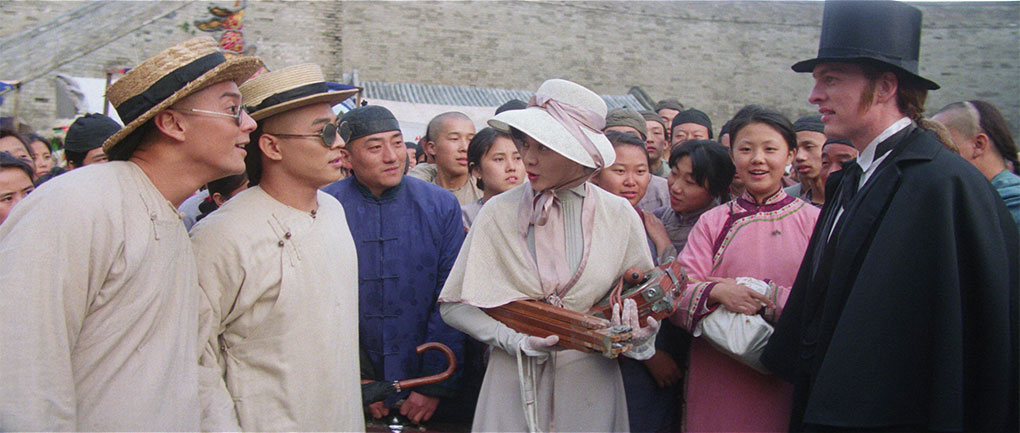
After the title sequence – more dancing lions, no beach training scene this time around – we join Wong Fei-hung and Leung Foon as they make their way through a throng of people in the capital city of Beijing. When they catch up with Siu-kwan, who's still wearing western clothes and carrying that damned camera, she introduces them to Tomansky, a suave Russian diplomat and former classmate from her time as a student in England. He speaks perfect Cantonese and clearly still has a bit of a thing for Siu-kwan, which triggers off two notable shifts in behaviour on the part of our lead characters. It turns out that Wong has come to Beijing in part to tell his father, Wong Kei-ying, that he and Siu-kwan are to be married, yet despite Siu-kwan's clear delight that they are soon to be an officially sanctioned couple (no-one else seems to know about it yet), she goes all gooey-eyed at Tomansky every time he utters a kind word in her direction. Wong, on the other hand, seems to have left his maturity back in Foshan and gets stampy-feet petulant at Tomansky's every move. Neither of these traits are particularly endearing and feel inconsistent with how the characters have been previously portrayed.
Wong's father turns out to be a nice guy of the highest order, and when we first meet him at the Guangdong Provincial Hall he is being warmly greeted by workers who are making and painting lion heads for the big competition. But this is a martial arts movie and nice guys are almost always targets for unscrupulous bastards, and we've not been in Wong Snr's company long before one turns up in the shape of wealthy and corrupt rival Chiu Tin-ba, a cartoonish bad guy flanked by an entourage of sneering troublemakers led by a fearsome martial artist known as Ghost-Foot Seven. Chiu tells them that he has been put in charge of the Lion King competition and has decreed that only men from his Dai Ping oil factory will be allowed to participate. Anyone who defies his decision, he assures them, will suffer the consequences. When Wong Snr. stands up to him as we all know he will, a handful of Chiu's men attempt to make him see sense but are punished with an efficiency that had me bristling with excitement for what might come next. Which is where we get to my second problem. When Ghost-Foot Seven is called into action, he doesn't attack Wong Snr. with the grounded hits and kicks the series has so far showcased with aplomb, but by gliding through the air in gravity-defying fashion and delivering a series of kicks while seemingly floating above the ground before flying off towards the rafters like an angry Superman.
This is wirework at its most transparent and is common in the wushu subgenre, and some will doubtless delight in the acrobatics it allows, but unless it's handled with care, for me it tends to distance the action from reality as surely as many of the more outlandish CG-assisted stunts of today. When fighting is not wire-assisted it thrills because regardless of how athletic or speedy the move, I can believe that the practitioner could pull it off for real for the very simple reason they had to do so for the film. Conversely, when a move is obviously wire assisted, I have to really struggle to suspend my disbelief for the equally simple reason that the move could clearly not be done without the assistance of those hidden (and sometimes not so hidden) wires. Graceful? Absolutely. Believable? Not a chance. I'll feely admit this is a personal prejudice and also that I have enjoyed the wirework in several wushu movies, but the thing here is that it marks a change in direction for a series whose wirework previously played subtle second fiddle to its excellent reality-grounded fight choreography, whereas here it often takes gravity-defying centre stage.
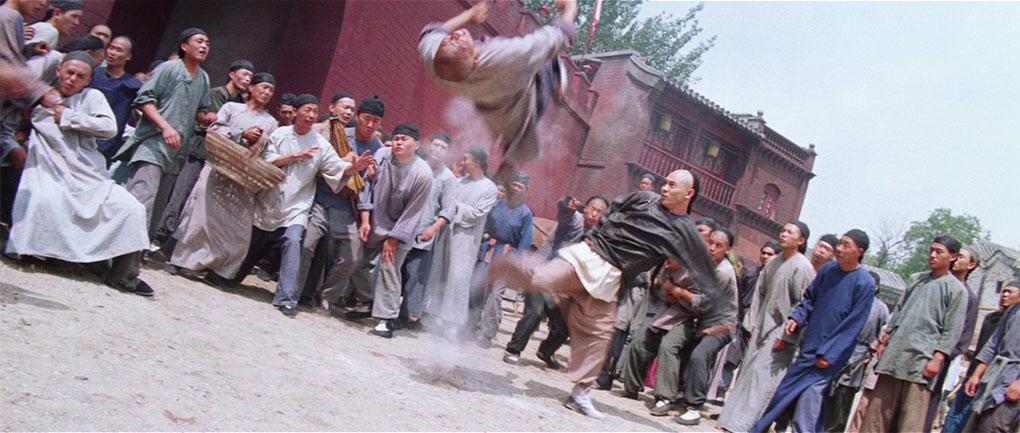
But there's more. Having delivered a two-movie masterclass in how to film martial arts action by holding shots for long and wide enough for us to be able to appreciate the skill of the performers, here Hark borrows an irritating tic from western martial arts movies by sometimes cutting briefly to close-up collision shots at a pivotal moment in a move, breaking up the action and adding to the air of crafted artificiality created by the wirework stunts. Adding to the problem is the decision to slow many of these shots down in post-production, which disrupts the flow of the action and breaks a stunt or fight move down into segments in a way that detracts from the skills of the performers. This, coupled with some uncharacteristically iffy camera placement, results in whole sequences having a somewhat messy feel, which sometimes renders them too confusing or unfocussed to provide the expected excitement or thrills.
Yet as I stated above, there is still plenty to enjoy and appreciate here. The aforementioned Wong Snr.'s no-nonsense battle with Chiu's men is very well staged, as is a first-half open-air fight between Wong and Ghost-Foot Seven, and there's a later sequence in which Wong repeatedly returns a table that's been kicked towards him by Chiu back to its rightful place that is so wonderfully choreographed that the wirework and trickery involved feels fully justified. This develops into a highly entertaining sequence in which Wong has to take on a slew of sword-swinging and axe-throwing enemies whilst trying to keep his balance on a slippery oil-coated floor, which again makes diligent use of wirework. The humour from the previous films has been carried over and intermittently scores a bullseye, notably a laugh-out-loud sight gag involving the audience for film footage that has been shot whilst the camera was lying on its side. There are also two sequences involving an injured but stubbornly proud Ghost-Foot Seven whose emotional impact really caught me by surprise, given how rabidly angry and evil the character had been previously portrayed. If for me the film falls somewhat short of the high standard set by its predecessors, it's these elements that still make it well worth seeing, and if you're a fan of wild wirework and prolonged scenes of lion dancing, you'll likely have a ball.
| Once Upon a Time in China and America |
|
Given that this set is being released as the Once Upon a Time in China Trilogy, this is technically a special feature, but it shouldn't be seen as one. It is, after all, the sixth and final film in the series, one that marked the return of Jet Li to the role of Wong Fei-hung after two films in which he was replaced by Vincent Zhao, and genre legend Sammo Hung co-directed and choreographed the fights. It thus deserves to be viewed and enjoyed on a par with the first three films, and the set is better viewed as a quartet rather than the trilogy it is being sold as. OK, got that off my chest. So what about the movie?
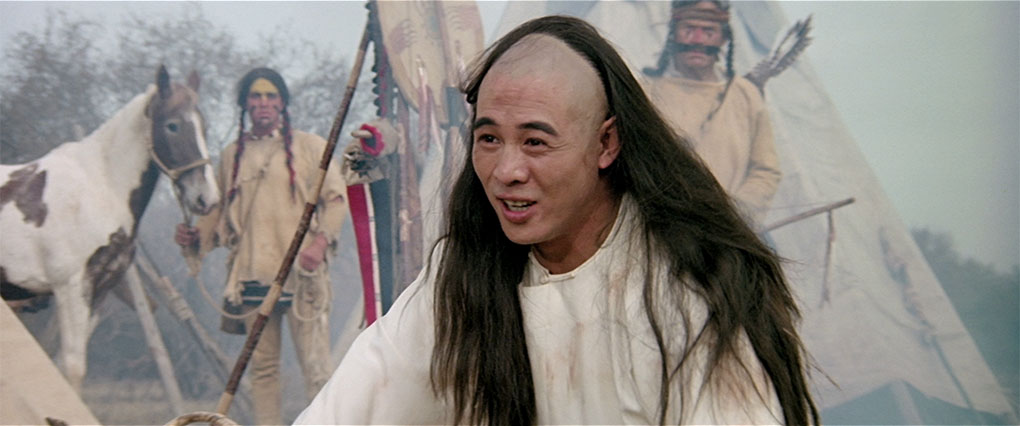
On paper, the signs are admittedly not good, with the idea of transporting Wong to the American wild west sounding a bit too much like a run-out-of-ideas gimmick. That was certainly at the back of my mind when I sat down to watch the film, but within ten minutes I had all but banished the thought from my head. It's not that that pre-judgement wasn't valid, it's just that once the film got under way I didn't really care.
It begins with the sight of a fair-haired cowboy riding across a dry and deserted plain (a wide shot lets us know we're in John Ford's beloved Monument Valley). When his horse collapses, he picks up his saddle and continues on foot, but as the hot sun burns down he eventually drops the saddle and soon after falls to the ground, exhausted, dehydrated and waiting to die. Suddenly, hope arrives in the shape a racing stagecoach, but despite a valiant attempt on the cowboy's part to flag it down, the driver ignores him and continues on his way. This is followed by a wagon that also has no interest in slowing down for this stranger, and bringing up the rear is a second stagecoach that is in such a hurry it almost runs him down. In this coach are Wong-Fei-hung, Siu-kwan and Ghost-Foot Seven – Siu-kwan is trying to teach her companions a little English, but Wong is more concerned for the fate of the man they have just passed, and in a deliciously graceful (if wire-assisted) move, leaps onto the roof of the stagecoach and takes control of the reigns in order to rescue him. The grateful cowboy's name is Billy, and he will soon prove to be one of the film's most likeable assets.
Quite why Wong, Siu-kwan and Ghost-Foot have made the long ocean journey to a land in which they are outsiders may initially seem bemusing, but when they stop for a meal, Ghost-Foot lets slip that they are on their way to visit Bucktooth So, who has since moved to America to become part of the growing community of Chinese workers and businessmen (it's quite possible this was set up in the fifth film, in which So also featured, but I've not seen this yet). All goes well until the party is attacked by a group of Native American warriors whose tribe is never specified but whose colourful face paint puts those Braveheart Scotsmen to shame. In the confusion of the furious battle that ensues, Siu-kwan, Ghost-Foot and Wong end up on a runaway stagecoach that tumbles into a river, spilling its passengers into the fast-running waters. Siu-kwan and Ghost-Foot are rescued and by chance (oh, there's lots of that) are delivered to Bucktooth So's laundry, while an unconscious and amnesiac Wong finds himself in a Native American camp, where his instinctive combat and medical skills quickly see him embraced as a member of the tribe.
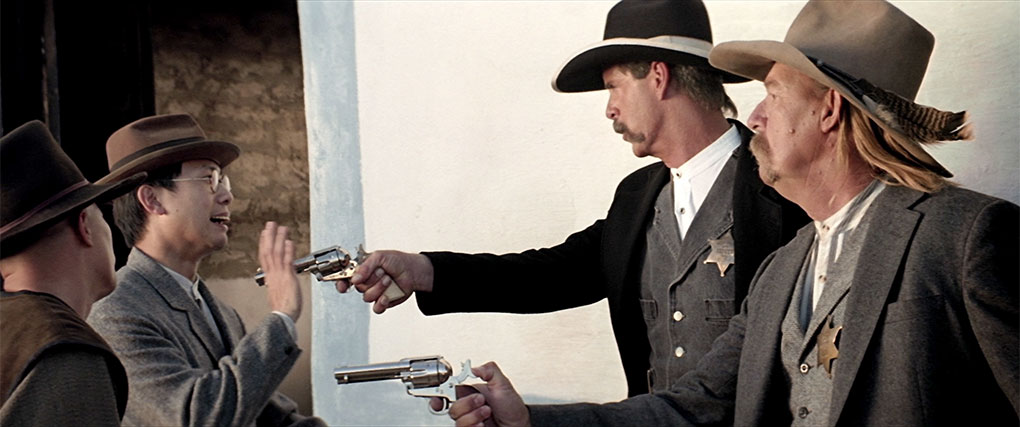
Yes, it's daffy, and yes, the Native Americans are all played by white men in red face, which feels more than a little awkward in a film made seven years after Dances with Wolves drew a firm moral line under that particular western trope. But the film still has its heart in the right place, and Wong's growing kinship with his adoptive tribe creates a bond between these two groups of outsiders, one of whom has more moral right to be there than the whites that so readily deride them. This in turns sits comfortably within a film that tells an old-school western story primarily from the viewpoint of the Chinese immigrants who are usually only visible as background characters at best. The subject of racial prejudice against the Chinese is directly addressed here, in the threats targeted at So and his companion when they dare to fraternise with one of the friendlier saloon girls, and in the local dictum that the Chinese are barred from certain areas and that no Chinese women are allowed in their camp. It's this that prompts Siu-kwan to dress up like a cowboy, which only makes her seem even more attractive. Balancing this is an ageing sheriff who is sympathetic to the Chinese community, and the ever-positive Billy, who falls in with the Chinese and is quick enough on the draw to bring any attempts to intimidate his new friends to a rapid halt. This new allegiance later puts his own life in peril when the Chinese are framed for a bank robbery and he chooses to stand with them and share whatever price they might be sentenced to suffer. I really liked this guy.
The fact that the film was shot in America rather than on a Hong Kong backlot makes a real difference, providing the filmmakers access to a pool of local talent than they wouldn't have on home turf. American characters are played by often well cast American actors who are allowed to deliver their own dialogue rather than being overdubbed later, which results in performances that far outstrip the norm for non-Chinese characters in a martial arts movie. It's also a nice touch that the film's principal bad guy is played by Chinese-American actor and martial artist Roger Yuan, who is so unrepentantly evil that he'll shoot his own gang members as willingly as those he robs, and let out a satisfied sneer as he does it. In case you're still not sure what side he is on, he dresses completely in black.
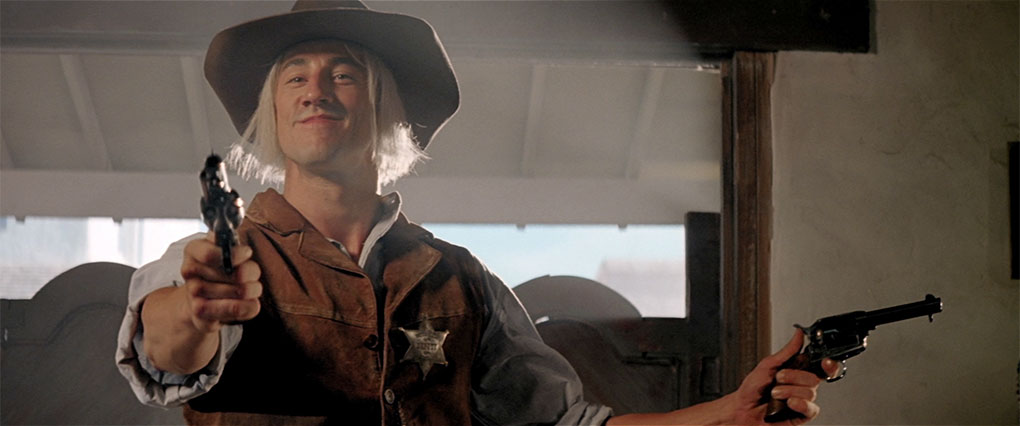
The Old West of Once Upon a Time in China and America is about as reality-based as the one in Back to the Future III, but it's also as much fun. The story moves along at a considerable lick, and Sammo Hung's action choreography is far more grounded in old-school combat than the third film's more extreme wirework acrobatics and is thus more exciting. The slight Kung Fu vibe that comes with having Wong beat western guns and knives with lightning-fast martial arts is hard to ignore, while the teaming of Wong with Jeff Wolfe as Billy – who does have a slight Owen Wilson vibe about him – can't help but prefigure the following year's Shanghai Noon, a western in which Wilson plays a roguish train robber who partners up with a Chinese martial artist played by Jackie Chan. As an entry into the Once Upon a Time in China series, this final film risks coming across as overly silly and even mocking its predecessors, but as a stand-alone martial arts/western hybrid, I thought it was a blast.
The first three films have all been sourced from new 4K remasters and they all look terrific. Framed in their original 2.35:1 aspect ratio, all have distinctly defined picture detail, well balanced contrast that neither crushes the blacks not burns out the highlights, and lovely colour rendition, something particularly evident in the costumes of the opera dancers in the first film and the multicoloured lion costumes in the third. Image detail is always clear even in darker scenes, and although the photography in the first half of the third film lacks the vibrancy of its predecessors, it really comes to life in the night-set lion dance competition climax. A couple of wide shots in the third film's early scenes are noticeably soft, but these are rare enough to suggest a problem at the shooting stage that the filmmakers had to live with. A fine film grain is visible on all transfers and there's no sign of dust or damage. Without access to the booklet, I can't confirm what level of restoration Once Upon a Time in China and America has undergone, but it generally looks every bit as good as the other films in this set, having very crisp detail, well-balanced contrast, vibrant colour when appropriate, and no evidence of any former dust or damage.
When it comes to the soundtrack options, there is considerably more variance between the films. Once Upon a Time in China offers Cantonese Linear PCM 1.0 mono, Cantonese LPCM 2.0 stereo, Mandarin LPCM 2.0 and English DTS-HD Master Audio 5.1 surround. The Cantonese mono sounds just a tad muffled and has the expected range restrictions, the stereo track is slightly clearer but with a more pronounced treble bias, and the Mandarin stereo track is similar to the Cantonese, but the sound effects and music have a tad more bass here. The English track is the weakest mix, with the dialogue, music and sound effects all having markedly different sonic qualities – it's almost as if they've been spliced in from separate source prints. The dubbing on this track is as unconvincing as ever and has that studio-recorded quality that ensures it never sounds remotely like it was delivered on location.
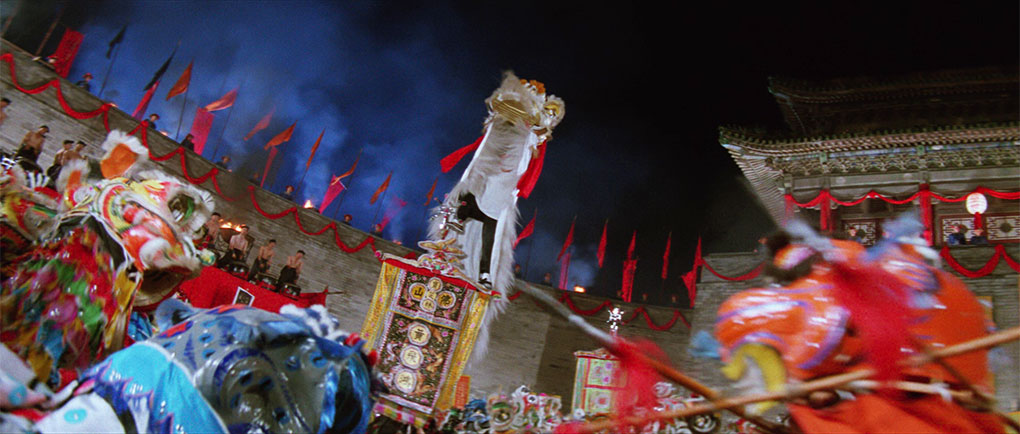
The same soundtrack options are available for Once Upon a Time in China II. Here the Cantonese mono track is noticeably clearer than its predecessor, and while the Cantonese stereo is clearer still, it's also noticeably louder and a little more shrill. The Mandarin stereo track is similar to its Cantonese equivalent, but with the levels toned down a little and dialogue that is less abrasive to the ears. The English DTS track is once again the worst – here the sound effects and music are clear, but the dialogue sounds as if it was recorded in a cardboard box and occasionally comes close to being drowned out by the location sound.
There's no Cantonese stereo track on Once Upon a Time in China III and the mono track is not the best in the bunch, with both the dialogue and music having a slightly muffled quality, the former occasionally sounding as if it was recorded with a sock pulled over the microphone. The English DTS track is clearer but the over-dramatic, studio-bound voices are so much louder than the music and effects that they never sound as if they are being delivered by the actors. The Mandarin stereo track is the easy winner here, being clear and well mixed and without any real issues.
Things get more interesting with Once Upon a Time in China and America, in which the English-speaking actors get to deliver their lines in their own voices (it looks very much like this film broke with Hong Kong and particularly martial arts tradition by shooting with synchronised sound), with only the Chinese-speaking characters dubbed in post. The sound quality is excellent across the board here, with a clear and nicely mixed Cantonese mono track on which the dialogue, music and effects all sound terrific. The Mandarin stereo track also sounds good, and while the levels are slightly lower – especially the dialogue – clarity never suffers. A particular plus of the Mandarin track, however, is that we actually get to hear Jet Li delivering his own dialogue in sync with the motions of his mouth. Hoorah! The English track sees the dialogue better integrated into the mix than elsewhere in this set, but is still sounds all wrong to my ears.
Optional English subtitles have been provided for all of the non-English dialogue.
ONCE UPON A TIME IN CHINA
Commentary by Mike Leeder and Arne Venema
The Hong Kong-based pair of actor, producer and martial arts film expert Mike Leeder and filmmaker and film historian Arne Venema provide a terrific commentary that's bristling with useful facts, revealing anecdotes and entertaining opinion. Areas covered include the actors, the director, the theme song, the story's politics, the underlying themes, the Chinese family system (see 13th Aunt), the film's sometimes epic feel, the darker tone it takes in the second half, the fight choreography, the handling of nudity and sexuality in Hong Kong cinema, and so much more. It's here that I learned that Jet Li broke his leg doing a stunt on the film and that the image of burning arrows being fired at the actors was achieved by, well, firing burning arrows at the actors, and I did smile at the suggestion that you can never go wrong with a kung-fu movie that has a teahouse scene (this will make complete sense to genre fans). There is lots to learn and enjoy here, and the realisation that there were two more commentaries by these fine gentlemen had be itching to get onto the second disc's extras.
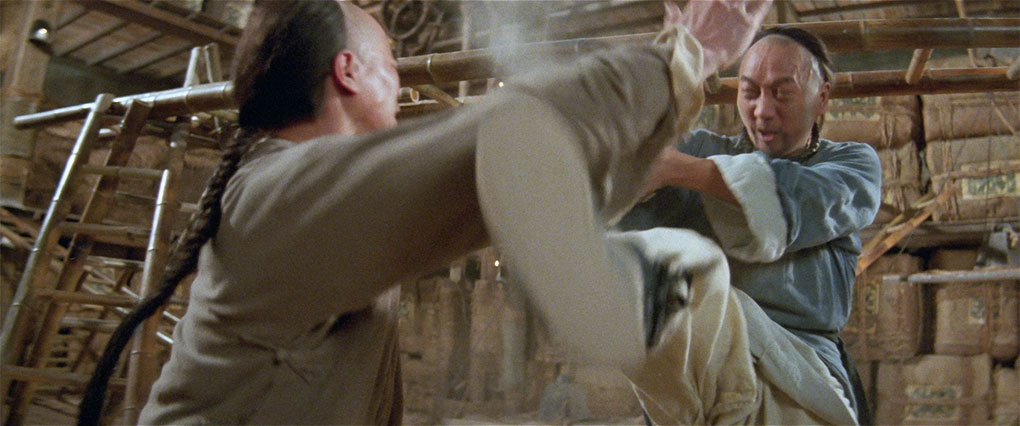
The Legend of Wong Fei-hung (12:59)
The first part of a Chinese produced, standard definition documentary on Wong Fei-hung focuses on his childhood and formative years and includes interviews with individuals working at museums dedicated to his life and work, together with footage of Foshan and Wong's home province of Shi Qiao Lu Jou as it is today.
Interview with Yen Shi-kwan (7:50)
A 4:3 framed, standard definition interview with actor and martial artist Yen Shi-kwan, who plays Iron Vest Yim in the film, conducted in the middle of a busy canteen. Unusually, he is translated not by subtitles but one of those close-to-the-mic voices that makes it sound like you're receiving live translation through headphones at an international conference.
Interview with Jet Li (10:35)
Another standard-definition, 4:3-framed extra, this one has burned-in English subtitles and is one of those interviews you used to find on DVDs (from which this was likely sourced) that were conducted in whatever room was empty at the time and without supplementary lighting, but is welcome nonetheless. Li talks about learning wushu at school by chance, the consequences of becoming suddenly famous when China opened up a little and allowed the screening of Hong Kong-made movies, and the components required for a successful film. Includes plenty of extracts from his first film, The Shaolin Temple.
Original Theatrical Trailer (4:31)
A solid-enough trailer constructed around the theme song and featuring a reasonable mix of action, drama and the film's socio-political themes.
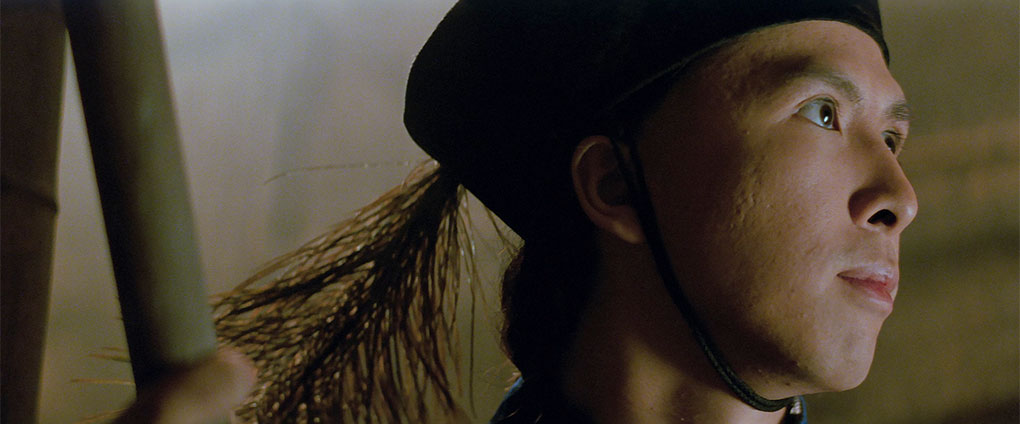
ONCE UPON A TIME IN CHINA II
Commentary by Mike Leeder and Arne Venema
Leeder and Venema are back for another enthralling discussion on a film they believe is superior to its illustrious predecessor – their points are well made, but it does see them start knocking elements of the original that they previously seemed to have no issue with. They provide plenty of information on the actors, with Leeder sharing his memories those he knew personally and of the shoot itself, as he was one of the bit players in the British Consulate scenes. I was particularly intrigued to learn that the acupuncture used on the injured soldier in the film was done for real (volunteers were asked for, Leeder declined), that Tsui Hark is an obsessive gamer who would often be playing his Gameboy on set, and that Jet Li eats a lot peanuts.
Mike Miller: Memories of Once Upon a Time in China II (51:11)
Former actor and martial artist Mike Miller (who played the British doctor in the film) looks back at the shooting of Once Upon a Time in China II, outlining how he went from being an Australian business owner to working as stunt performer in Hong Kong action movie, and providing some detail on the shooting of the movie, including a solid reason why Jet Li was doubled in some scenes. He talks about Tsui Hark's approach to directing and working again with him later on the 1998 Knock Off and on the highly regarded Once Upon a Time in China TV spin-off, as well as being frank about why he left Hong Kong after seven years in the business. Blu-ray special features producers take note – this is all one shot, with no angle changes, captions, inserts or backing music, and it's still damned interesting. You don't always need to dress up your material for it to deliver.
The Legend of Wong Fei-hung II (15:32)
The second part of the Chinese documentary on Wong Fei-hung focuses on his teenage years, the development of his martial arts skills and his high reputation as a medical professional, which are illustrated with archive photos, more recent footage of the discussed locations and martial arts demonstrations. What surprises is how much of the first two Once Upon a Time in China films appear to have been inspired by historical fact.
An Audience with Jet Li (10:53)
An SD 4:3 recording made during UK promotional tour for Romeo Must Die at a Hong Kong Superstars roadshow hosted by founder Chris Ducker. Jet Li does a quick martial arts demonstration and answers questions from an appreciative audience about his martial arts, his film work, his fondness for the Wong Fei-hung character, and his hopes for the future.

Interview with Donnie Yen (16:28)
A standard definition, 16:9 special feature imported from a previous Hong Kong Legends DVD, this interview with Donnie Yen is conducted in English and provides some revealing info on the making of the film. Yen talks about fighting in an enclosed space, getting injured during one of the fight scenes and having to film around the wound, what he learned about action choreography for film through working for Yuen Woo-ping, and more. He confirms that both he and Jet Li were giving their fight scenes everything they had, and intriguingly equates their improvisational approach to some of the battles as akin to two jazz musicians riffing together, though credits the energy and ferocity of these sequences to an old Chinese proverb about what happens if you put two lions in the same cage.
Original Theatrical Trailer (3:08)
Again built around the title song, this one is completely action focussed and doesn't include a word of dialogue.
ONCE UPON A TIME IN CHINA III
Commentary by Mike Leeder and Arne Venema
I was preparing myself to seriously disagree with Leeder and Venema this time around if they praised the third film as being as good as the first two, but it turns out their views on it almost exactly coincide with mine, with Leeder describing it as the series' equivalent of Return of the Jedi and opining that they seemed to be trying to make and epic and that it just doesn't come off. They pick up on the less vibrant cinematography (though share my view that it comes to life during the climax) and criticise the over-reliance on wirework and the excessive amount of lion dance footage in the film. We still get all useful information on the actors, the characters, the studio sets, the intricacies of the Chinese language, the lack of animal welfare laws in Hong Kong cinema and plenty more, and they praise the teahouse fight in which Wong juggles a table and fights on an oily floor. They also suggest that a key scene involving an injured Ghost Foot Seven (which I also highlighted) shows us the film Once Upon a Time in China III should have been.
John Wakefield: Memories of Once Upon a Time in China III (29:14)
Despite cheerfully disregarding three golden rules of interview filming by shooting the subject wide, sitting them against a large window that casts them in relative shadow and relying on a directional mic that as far enough away to pick up the room acoustics (yes, I also intermittently do this sort of thing for a living), this is still an enthralling chat with American actor John Wakefield, who plays Tumanovsky in the film. He intriguingly reveals that he was born and raised a Mormon (which he has since put behind him) and was assigned to learn Cantonese and travel to Hong Kong, only later deciding that he wanted to act in movies there. He talks about working with Jet Li and Tsui Hark (whom he assures could be fierce sometimes ‘creative' with language), acting in a foreign language, quitting the business due to being typecast as the western baddie, and plenty more.
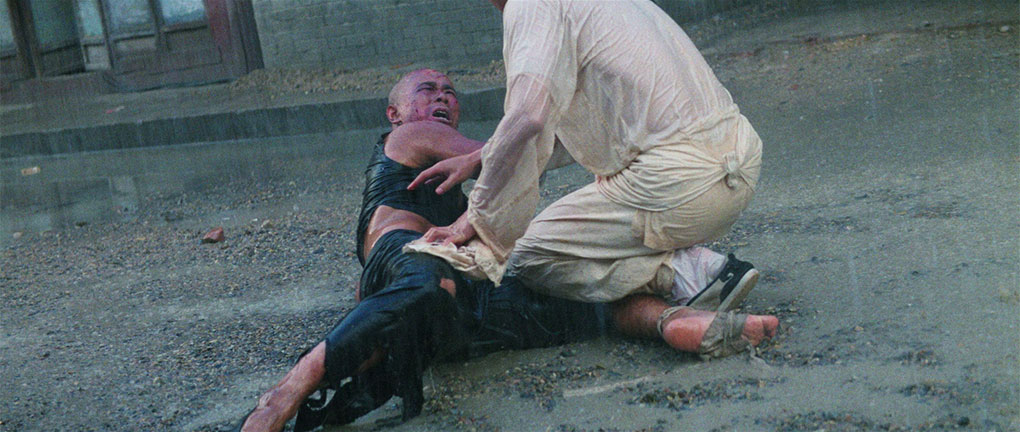
The Legend of Wong Fei-hung III (13:28)
Part 3 of the documentary on Wong Fei-hung focusses on the development of his martial arts (including the shadowless kick featured in the films), Foshan's high reputation in the lion dance community and Wong's disciples, the most celebrated of which was indeed Leung Foon, another detail the early films were accurate about.
Interview with Tsui Hark (22:56)
An easy-going chat with producer-director Tsui Hark, shot on 16:9 standard definition, presumably for an earlier DVD release. He talks about the decision to make a film about Wong Fei-hung, how in Hong Kong film is all about making money and that art is secondary, how he refines his craft by watching other people's movies, and the differences between producing and directing.
Interview with John Wakefield (10:56)
An archive interview with actor John Wakefield, who here really does have a Mormon air about him as he smilingly recalls that the script for the film was being written as they went, that Jet Li was very nice but communication between them was tricky (Wakefield spoke Cantonese but Li only spoke Mandarin), having his voice redubbed despite delivering his lines in fluent Cantonese, and how he still gets recognised in the street for that role.
Behind-the-Scenes Montage (2:51)
A collection of behind-the-scenes footage, though not from this film but the climactic fight between Wong and Iron Vest Yim from the first movie, which includes a couple of shots of Jet Li with his broken leg in plaster.
Original Theatrical Trailer (2:56)
Proportional to its running time, there's even more lion dancing in the trailer than in the main feature. It's a bit shambolic in structure, and who the hell did the drop shadow on the title?
ONCE UPON A TIME IN CHINA AND AMERICA
The Making of Once Upon a Time in China and America (25:05)
Essentially a 25-minute EPK that blends behind-the-scenes footage with interviews with cast and crew members, including some of the American actors. On Sammo Hung's birthday they dress him up as a movie Mexican (he really looks the part), and more than one person complains about how cold it is on location. The non-English interview material is subtitled in English and Chinese, but the general banter is left untranslated.
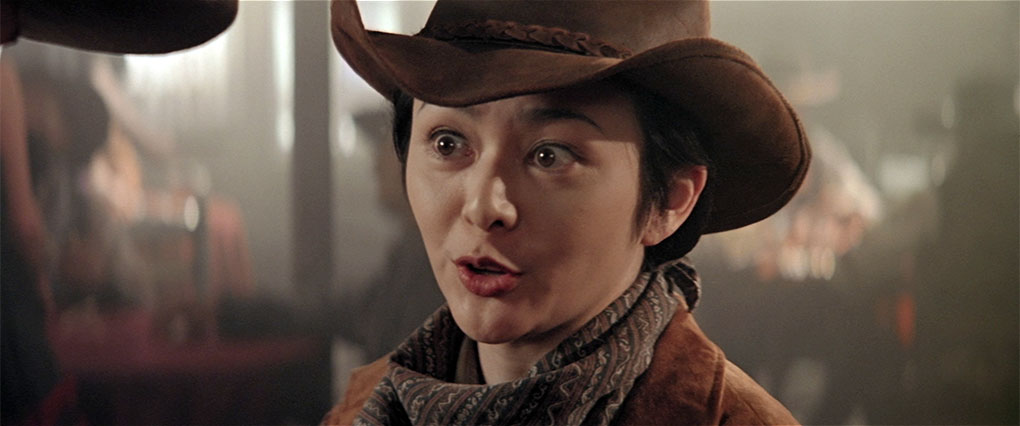
Theatrical Trailer #1 (3:23)
A breathlessly edited montage of action with occasional pauses to hint at the surrounding drama and contains precious little dialogue. A couple of spoilers here, but the whole thing's moving too fast to worry about it.
Theatrical Trailer #2 (3:50)
What sounds from the voice-over like an American trailer, with all the dialogue delivered in dubbed English. The picture quality is lower than on Trailer #1, but this is still of interest. Same spoilers as before, and more time to register them here.
Also included in the release set is are Collectors Booklets featuring new essays, and an abundance of archival material and ephemera, but these were not available for review.
This review has taken a long time because there's just so much to watch and talk about in this hugely impressive set. The first two films are acknowledged genre classics, and while I wasn't as fond of the third one as some (though as the commentary demonstrates, I'm not the only one), I enjoyed the sixth and final film far more than I ever expected I would. The restorations of all four titles are terrific and are accompanied by all of the available soundtrack options, while the collection of included special features borders on the luxurious, particularly the excellent commentary tracks from Mike Leeder and Arne Venema, which were recorded specifically for this release. A brilliant box set and an absolute treat for fans of martial arts cinema. Highly recommended.
|